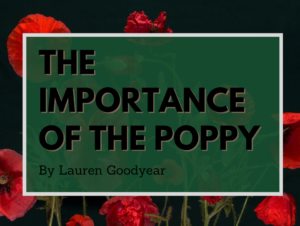November 22nd, 2022
You may have seen many people all across Canada wearing a felt poppy over their heart. It is widely understood that we wear this poppy over our hearts for Remembrance Day, but do we really know why we wear it? Where did it come from? Who do you support by wearing it?
On July 28th, 1914, the world went to war. People all over Europe were fighting their neighbouring countries for what they believed was the way to gain freedom for themselves. At the time, Canada had strong ties with Great Britain and its forgein affairs were completely controlled by Britain. At the beginning of October 1914, Canada and the British Dominion of Newfoundland began sending troops of soldiers to Europe to support the war effort for Britain. Many Canadian citizens fought in major battles such as the Battle of Ypres, the Battle of Vimy, and many more. More than 50 000 Canadian soldiers died in the war of 1914, all for the freedom of their country’s people. We have Remembrance Day to remember all of the soldiers Canada lost in the First World War (WWI), and to thank them for what they did for our country.
The poppy became a symbol for Remembrance Day all because of the world famous poem by Lieutenant-Colonel John McCrae written on May 3rd, 1915.
In Flanders Fields
In Flanders fields the poppies blow
Between the crosses, row on row,
That mark our place; and in the sky
The larks, still bravely singing, fly
Scarce heard amid the guns below.
We are the Dead. Short days ago
We lived, felt dawn, saw sunset glow,
Loved and were loved, and now we lie
In Flanders fields.
Take up our quarrel with the foe:
To you from failing hands we throw
The torch; be yours to hold it high.
If ye break faith with us who die
We shall not sleep, though poppies grow
In Flanders fields.
(As published in Punch Magazine, December 8, 1915)
McCrae wrote this poem while grieving the loss of a friend and fellow soldier.
In 1921, Madame Anna Guérin of France was inspired by McCrae’s poem and imagined the idea of the “Remembrance Day Poppy.” With that being said, it is also important to recognize that Madame Anna Guérin did many other amazing deeds to support Canada during WWI before she ever discovered McCrae’s poem. Guérin was the founder for a charity that helped rebuild regions of France that were destroyed during WWI. After she discovered McCrae’s poem, she created poppies made of fabric to raise money for the charity by selling them for funds. These poppies were made out of bright red material with a green stalk. Originally, the poppies also had a small banner attached to the stem which on one side said “British Legion Remembrance Day ” and on the other side said “Made by the Women and Children. The Devastated Areas of France.” Today, most poppies don’t have this banner attached to them, but it is still important to recognize what these admirable women and children did for the country to honour the soldiers who fought in the war. These poppies then became the most recognizable symbol for everything that was lost in WWI, but most importantly; the people that were lost in it.
We wear poppies over our hearts all across Canada to remember the fallen soldiers of the First World War. It is important that everyone wears a poppy to show their gratitude as those 50 000 Canadians gave their lives to ensure that our nation could be free and live in peace.
By Lauren Goodyear
Categories: Editorials

